
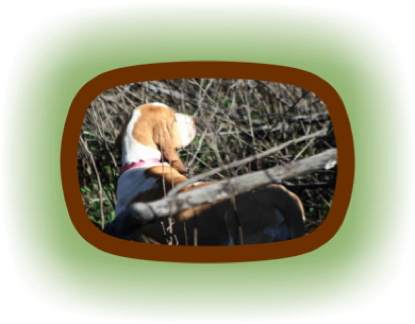

Breed Standards
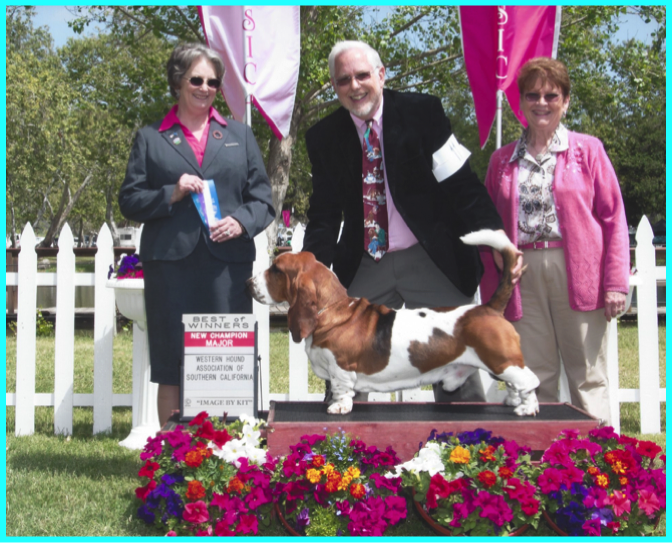
Our Latest Champion
Ch. Tradewind’s Caicos
Breed Standards
Friday, April 25, 2014
By Don Bullock
Our new AKC Champion is a great example of how Standards for Basset Hounds work together. He’s the product of two bassets from Europe. Their ancestors were bred to different Basset Hound Standards than the AKC Standard used to judge Caicos in the United States. He still won easily in the show ring here under licensed AKC judges.
The Standard we use today for basset hounds was changed in 1964 by the Basset Hound Club of America (BHCA) and adopted by the American Kennel Club (AKC). Standards for the breed, however go back much farther than that. Perhaps the first actual written Standard for Basset Hounds was pinned in 1881 by Sir John Millais. While his description of a perfect basset wasn’t as detailed as the ones of today much of what he wrote is still part of our current Standards. In the following text Mr. Millais speaks of to district breeds. Our basset hounds of today are decedents of the Basset a Jambes Torses which means “wholly crooked fore legs” (pictured below) that he spoke of.
The Basset, for its size, has more bone, perhaps, than nearly any other dog.
The skull should be peaked like that of the Bloodhound, with the same dignity and expression, nose black (although some of my own have white about theirs), and well flewed. For the size of the hound, I think the teeth are extremely small. However, as they are not intended to destroy life, this is probably the reason.
The ears should hang like the Bloodhound's, and are like the softest velvet drapery.
The eyes are a deep brown, and are brimful of affection and intelligence. They are pretty deeply set, and should show a considerable haw. A Basset is one of those hounds incapable of having a wicked eye.
The neck is long, but of great power ; and in the Basset a jambes torses the flews extend very nearly down to the chest. The chest is more expansive in the Basset than even in the Bulldog, and should in the Bassets d jainbes torses be not more than two inches from the ground. In the case of the Basset a jambcs demi-torses and jainbes droites, being generally lighter, their chests do not, of course, come so low.
The shoulders are of great power, and terminate in the crooked feet of the Basset, which appear to be a mass of joints. The back and ribs are strong, and the former of great length. The stern is gaily carried like that of hounds in general, and when the hound is on the scent of game this portion of his body gets extremely animated, and tell me, in my own hounds, when they have struck a fresh or cold scent, and I even know when the foremost hound will give tongue.
The hind-quarters are very strong and muscular, the muscles standing rigidly out down to the hocks.
The skin is soft in the smooth-haired dogs, and like that of any other hound, but in the rough variety it is identical with that of the Otter-hound's.
Colour, of course, is a matter of fancy, although I infinitely prefer the 'tricolour', which has a tan head and black-and-white body.
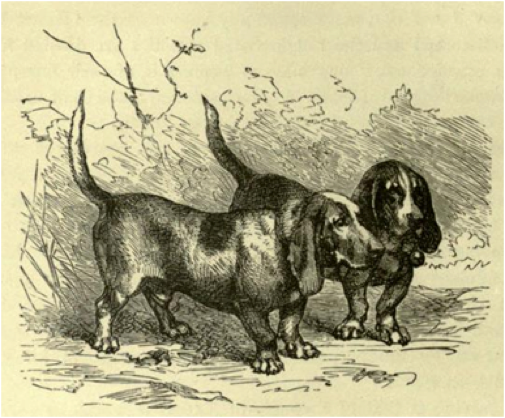
Many people who just want a puppy wonder why breed Standards are important. In reality they are the blueprint of our breed. Yes, breeding two basset hounds together does create baby bassets, but if the breeder doesn’t follow the breed Standard in choosing his breeding stock you get puppies that may not look and act like basset hounds. Just take a look at the average basset hound that you see at the local dog park our at casual basset hound events and you’ll see what I mean. Yes, there are many wonderful, loving bassets that haven’t been bred to the Standard but look at their structure. Do they look like purebred bassets? Some breeders try to get away with their poor breeding practices by saying that their bassets are French Bassets. I can’t tell you how many times I’ve read this or heard it from owners. A true French Basset would be bred to the FCI Standard for Basset Hounds and look a whole lot different than those claiming that they breed French Bassets. Our Lucy (shown below right) is an example of what many misrepresent as a French Basset.
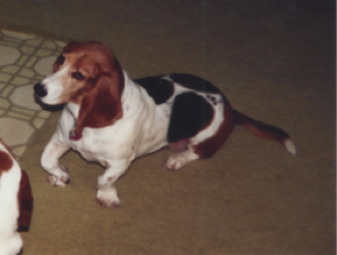
I see far too many basset hounds with all kinds of issues that could have been prevented if the breeders had kept to the Standard. Knuckling over of a front leg is far too common. Some are even knuckled over on both front legs. Our Lucy is pictured at the right with very deformed front legs. We bought her at a pet store many years ago. While Lucy was a "purebred" basset hound with AKC papers her front looked more like that of a bulldog than a basset hound. She’s an excellent example of a knuckled over front. Obviously her breeder didn’t have any idea about the Standard nor why she should have followed it when breeding. One can easily see that Lucy doesn’t match the following section of the Standard for Basset Hounds.
Forequarters - The chest is deep and full with prominent sternum showing clearly in front of the legs. The shoulders and elbows are set close against the sides of the chest. The distance from the deepest point of the chest to the ground, while it must be adequate to allow free movement when working in the field, is not to be more than one-third the total height at the withers of an adult Basset. The shoulders are well laid back and powerful. Steepness in shoulder, fiddle fronts, and elbows that are out, are serious faults. The forelegs are short, powerful, heavy in bone, with wrinkled skin. Knuckling over of the front legs is a disqualification. The paw is massive, very heavy with tough heavy pads, well rounded with both feet inclined equally a trifle outward, balancing the width of the shoulders. Feet down at the pastern are a serious fault. The toes are neither pinched together or splayed, with the weight of the forepart of the body borne evenly on each. The dewclaws may be removed.
I could go on and on pointing out the features on our Lucy that don’t come close to the Standard for Basset Hounds. You can go to Lucy’s page to see more about her. The point is that she suffered much of her life from poor breeding because her breeder had no intention of breeding bassets to the Standard.
The AKC breed Standards are important for all dogs not just show dogs. Yes, the dogs we show should be outstanding examples of the breed according to the Standard. At shows we have them adjudicated by licensed AKC judges who judge them based on their interpretation of the Standard. The judges are judging our dogs just like they have done for well over a century as breeding stock for future generations. By breeding the best examples of their show dogs breeders perpetuate Standard for the breed for future generations. Those of you who wish to have a pet or companion as a member of your family deserve a well bred basset hound too. There is no reason except for feeble excuses and perhaps money that all basset hounds aren’t bred to the Standard. It’s only through the efforts of those who breed our basset hounds based on the Standard that our breed continues to flourish. If we stop doing so then our precious breed that we love so much will soon disappear.
Recently a lady contacted me asking if I could help her with a problem she had with her basset hound. The first thing that I did was ask her why she didn’t get help from the dog’s breeder. Her response was that the breeder didn’t return her calls. Since the breeder was an “AKC Breeder” she assumed that it was bred correctly and I, as an AKC Breeder, should help her with her problem. It turned out that her basset hound had extremely crippling issues with his structure. He needed some very expensive surgery. The lady already knew that but wanted me to fix it. Obviously the so called breeder had no idea what they were doing or that there is even a Standard for the breed nor did they feel any responsibility for the dogs they bred. She was only interested in the lady’s money. My only response was to ask why she bought the dog and all she responded that he came with “papers” from an “AKC Breeder.” BTW -- Through the help of Dawn Smith from Daphneyland we did recommend a highly qualified expert for her to see. She has never returned my requests for updates so I don’t know what happened to the dog.
First of all there is no such thing as an “AKC Breeder.” While the AKC does great things in support of all dogs they are a registry of pure bred dogs. Just because a dog is registered with the AKC does not mean that they should be bred. All it means is that the dog’s ancestors are all registered as pure bred dogs with the AKC. In basset hounds the “stud book” or registered dogs and litters goes back to before the basset hounds were recognized by the AKC in 1885. That’s quite a book but it still has nothing to do with quality. Quality is determined by the AKC Standard for Basset Hounds which was created by the “parent club for basset hounds,” The Basset Hound Club of America, Inc. The combination of two basset hounds and those in their pedigrees plus how well their prodigy has done in the show ring as judged against the Standard for the breed is what determines the ultimate quality of a dog along with the health of the dogs involved. A prominent judge, Patricia Trotter, whom we see often at shows and has also awarded wins to some of our bassets is credited with the following statement, “Pedigree indicates what the animal should be. Conformation (as judged at shows) indicates what the animal appears to be. But performance (what they produce) indicates what the animal actually is." Those out for a quick buck on a litter of dogs don’t care about any of that. It’s up to each breeder to breed to the Standard not the AKC. All puppy buyers should not expect nor do they deserve less.
Breeders also need to be cognizant of the available gene pool they are using. Sometimes breeders in one area over use a particular dog or dogs and their gene pool is overwhelmed by the faults of those dogs as well as their good qualities. The importation of examples of a breed from other areas of our country or even other countries is very important to keeping a gene pool free of problems. While line breeding is sometimes a good idea doing too much of it can reproduce bad qualities as well as the good ones. This is where bringing in Caicos and his brother Reefer makes a difference in our breeding program. Most of the basset hounds in their pedigree were bred to the current and former Kennel Club (UK) Standards for basset hounds. While this Standard is not significantly different from the AKC Standard for Basset Hounds I’ve included a copy of the 2009 Kennel Club (UK) Standard and the 1989 Kennel Club (UK) Standard on this website for those who are interested to review. I have also included the FCI Standard for Basset Hounds because it’s used in many European countries and some of the basset hounds in their pedigree were bred to that Standard. By adding them into our breeding we are assuring that we’re not duplicating anything that might be inherent in basset hounds locally. Bringing in quality dogs from a totally different gene pool allows us to strengthen the breed in our area.
This is something that conscious breeders have been doing from the very beginning. That’s how the different breeds were created. The first basset hounds were imported to the United Kingdom from France by ord Gallway in 1866. It was in the United Kingdom that the breed we know today developed.
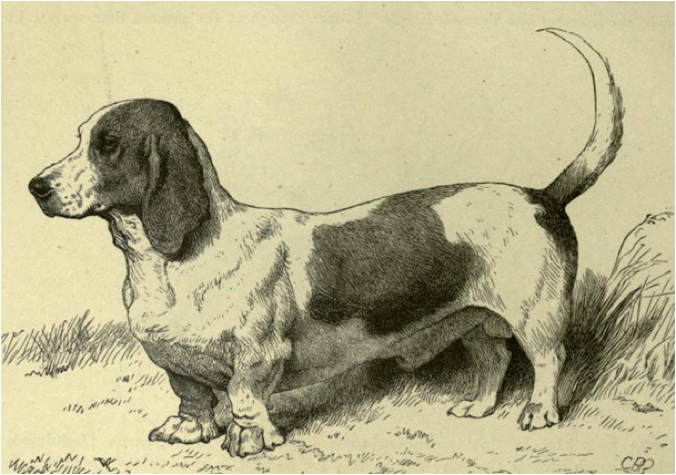
The illustration, by Mr. C. B. Barber, of Mr. Millais's splendid specimen Model, is, in our opinion, an exact representation of that well-known dog, whose name will never cease to be associated with the introduction of the breed into this country. Mr. Millais imported Model in 1874.
Model has won the following prizes amongst others: Twice first Crystal Palace, first Brighton, second Alexandra Palace, second Agricultural Hall, and third Darlington. Such' performances, taking into consideration that he had to be shown in variety classes against dogs of all sorts of breeds, stamps Model as a remarkably successful competitor in the ring.
The illustration above is of Model one of the earliest of the top winning show basset hounds. This dog played a big part in the development of our breed. He was imported from France.
The next great impulse towards popularizing these hounds in England was, undoubtedly, the importation of specimens from the best French kennels, by "Wildfowler" and Mr. G. R. Krehl; to a remarkable extent by the latter's Fino de Paris, a hound of great beauty and of concentrated pedigree, whose blood runs in the majority of Bassets of the day.
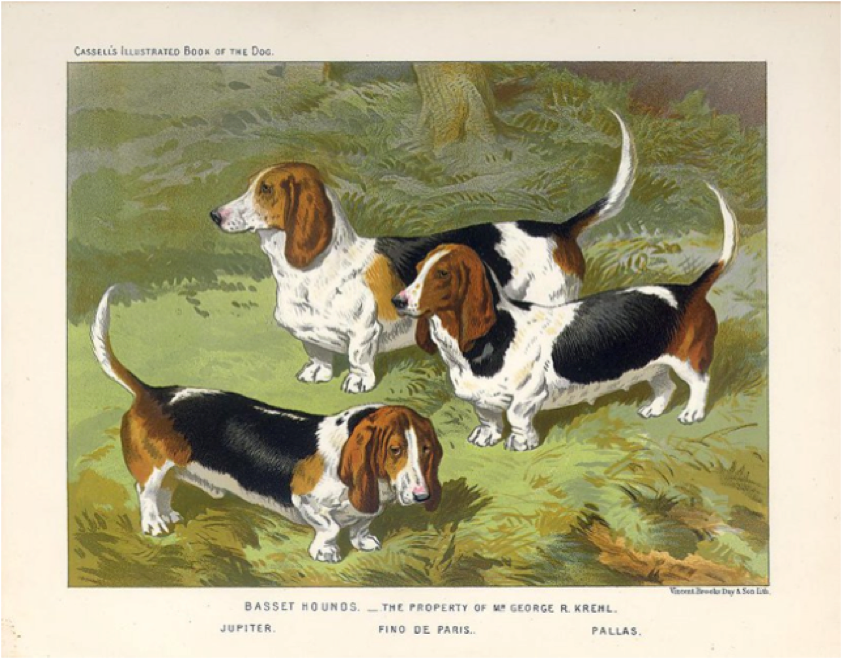
Fino de Paris deserves a few words to himself, so potent has his influence been upon the breed. Mr. Krehl showed excellent judgment in acquiring him in 1880. Mr. Millais, who could have had him at an earlier date, believed him to be Model's brother, but he had the bloodhound type of head to which some have bred since, while Model's was more on the lines of a Foxhound's.
Now we may trace the foundation of the breed as it is today in Great Britain. The union of Model with Lord Onslow's Finette produced Garenne and Proctor. The latter, put to Juno, a bitch imported by Lord Onslow, produced Cigarette, who became the dam of Medore by Champion Bourbon (Fino de Paris ex Guinevere). The alliance of Medore with Fino VI. (a son of Fino V. by Vivien, a granddaughter of Fino de Paris) resulted in the birth of Champions Forester, Fresco, Merlin, and Flora, all names of great moment in the Basset Hound world.
As can be easily seen by all this the development of our breed at this time was very methodical and well though out. It wasn’t haphazard as much breeding is today. Breeding specimens were selected carefully based on their qualities. The dogs that were bred were considered excellent examples of the breed.
Later on in the history of basset hounds in the United Kingdom there were further imports from France and the United States. Breeders in the United Kingdom were experiencing some things that they didn’t like in their dogs and brought in foreign examples to help get their breeding programs back on track.
At one point basset hounds almost disappeared in the United Kingdom, In fact the Basset Hound Club was disbanded because it was difficult to breed good examples of basset hounds. At that time those who wanted to continue the breed imported additional breeding stock to revive the breed.
For those who would like to go back in the history of Basset Hounds, George Johnston’s book The Basset Hound is excellent. This book talks about Basset Hounds in the United Kingdom (England) starting with the very first imports from France. Unfortunately this book is out of print. Used book sellers, including those who advertise through Amazon.com are the only sources that I know for the book. I got my copy from a breeder/friend who lives in Switzerland.
I think perhaps the following long quote from British Dogs, Their Points, Selection and Show Preparation by William D. Drury in 1903 is important to understanding the early development of our breed. He has some great advise for puppy buyers too.
Of recent years an emphatic stand has been made against unsoundness, and hounds that at one time would have won prizes on account of their beautiful type would now be sent out of the ring unnoticed. This is quite the right line to go upon, for the Basset is essentially a sporting hound, and every effort should be made to breed out unsound front legs or weak loins and quarters.
Though many people keep Bassets simply for show purposes or as pets, there is no reason why the working properties should occupy a secondary position in the esteem of the breeder.
Indeed, the writer would almost prefer seeing a sporting breed become extinct than suffer the degradation of being propagated simply for so called "fancy" points. We should try for a well-balanced hound, beautiful in head, with the pathetic expression which is so much of his charm, short legs, with feet beyond reproach, well-sprung ribs, and deep chest.
Why some people should wish for longer legs it is difficult to imagine. The Basset was never meant for speed, and, rather than take away one of his chief characteristics, those who want a faster pack should take up Beagles instead. The note of the little hound is deep and melodious.
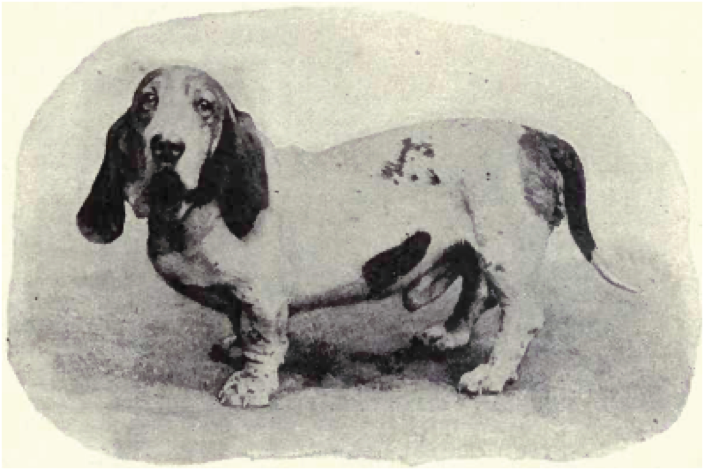
Mrs Tottie's Smooth Basset Hound Ch. Louis Le Beau.
As a rule, sensational figures are not paid for Bassets, and quite a little excitement was caused at Cruft's Show in 1900 when Mrs. Tottie claimed Mr. A. Croxton Smith's Wantage for the catalogue price of £150. At an earlier day Mr. Krehl obtained a somewhat similar sum.
Bassets vary a good deal in disposition. Some make delightful companions, becoming much attached to master or mistress, while others display a stubbornness which requires considerable humoring. On the whole, it is mainly a question of early training.
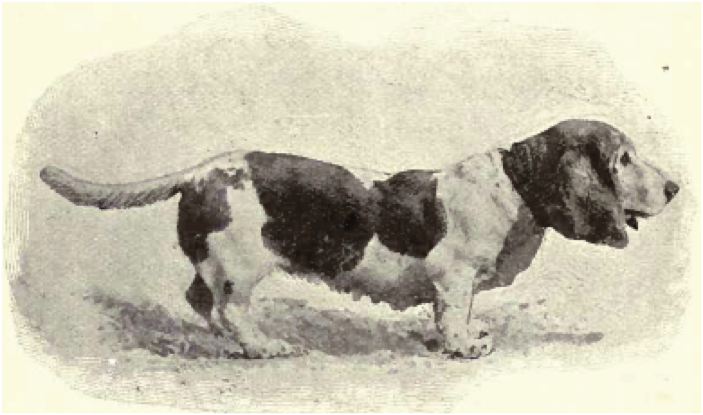
Smooth Basset Hound Ch. Xena bred by Mrs. C.C. Ellis.
In choosing a puppy, select one with plenty of bone and substance. See that the ears are set on low and fold gracefully, instead of hanging flat to the side of the skull.
Beware, too, of those with very narrow heads they are likely to become snippy. The skin should be loose and fine to the touch, and the eyes should be deep set and show some haw, as with the Bloodhound.
The legs should be clean at the shoulder, without any tendency to bow out : the writer prefers them wrinkled down to the feet, which should be large and clumsy-looking for the size of the puppy.
While our basset hounds of today may look a little different than those shown in this article what Mr. Dury says about the breed is what’s important. The goal of any breeder should be to both continue a breed but also try to improve the breed as well. Many of our modern day refinements have addressed many of the concerns of these early basset hound breeders.
For those of you more interested in the more modern history of basset hounds I have two books that I highly recommend. Margaret Walton's The New Basset Hound is a general overview of the breed written by one of the real pioneers in bassets in the United States. She is well respected through out the world as a basset hound expert. Peg Walton began breeding bassets in the 1940s, and her Lyn Mar Acres kennel provided the foundation for many of the top basset bloodlines today. In fact some of her bassets helped revive the breed in the United Kingdom at one time. The book contains many great photos of some
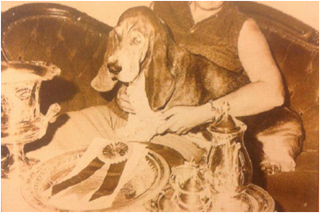
BISS CH Lyn Mar Acres Ballyhoo
Bdr/Owner/Hdlr: Lynwood & Margaret Walton
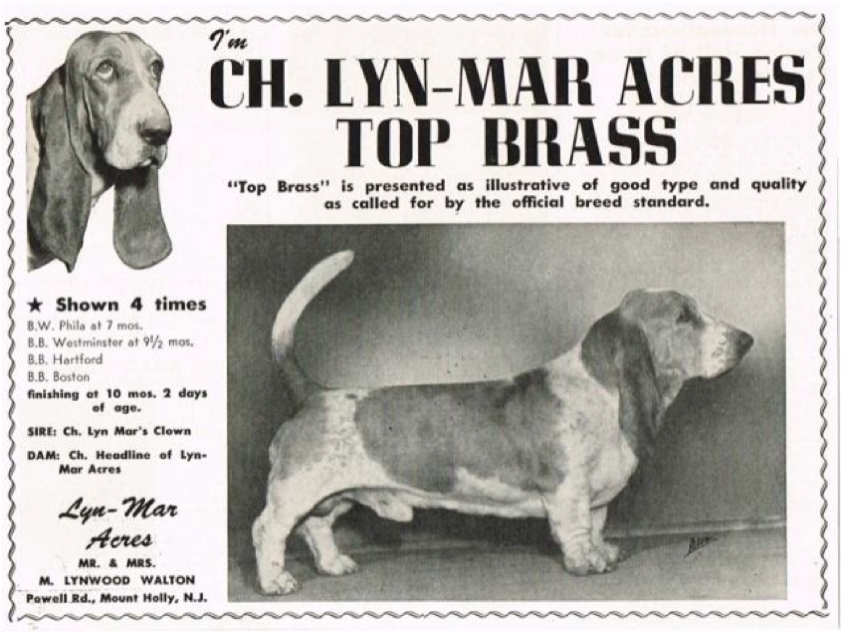
wonderful bassets from the past, and if the information is not in Peg's book, you don't need to know it. Peg was revered in our breed and has been sorely missed since she passed away in 2008. Just remember that some things may have changed somewhat since this book was published.
Col. Robert Booth's The Official Book of the Basset Hound is a great reference. The book is very helpful if you are researching a basset pedigree as it is richly illustrated with hundreds of photos of dogs from all of the top bloodlines. Although the book's tracking of bassets and bloodlines ends in 1996, many of the dogs in the book show up in the best pedigrees today.
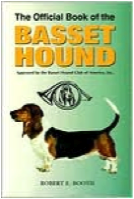
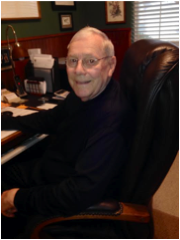
Over the years the bred Standards do change. When national breed clubs and or the governing body such as the AKC notice problems that may be cropping up in a breed the issue is addressed and if necessary changes are made to the Standard. That recently happened in the United Kingdom. Unfortunately some of those changes were forced on the Kennel Club from outside political forces spurred on by animal extremists and the media. It seems today that politicians have an opinion on just about everything and feel it is necessary for them to get into things that they don’t understand. Today’s media thrives on controversy and the animal extremists have capitalized on that in recent years. If some animal extremists have their way we will all be devoid of all our pets. That’s their goal.
Like the responsible breeders of today we strive with every breeding to make improvements on what we have. We strongly feel responsible for the bassets we breed and how well they match the Standard. That’s the art of breeding that so many forget. They are too busy trying to make money or it’s not convenient for them to go out of their way to execute the best pairing possible. That is certainly not our goal as breeders. Convenience and money are not what drives our breeding program. The AKC Standard for Basset Hounds and our love of the breed are the force behind our breeding choices. Anyone who truly loves our breed should expect no less from ALL basset hound breeders.
The support we receive from those who purchase one of our puppies helps us continue doing what we do for the breed. Without you we would be unable to show our dogs and do our part in breeding the best basset hounds that we can breed. We thank you for your support.
